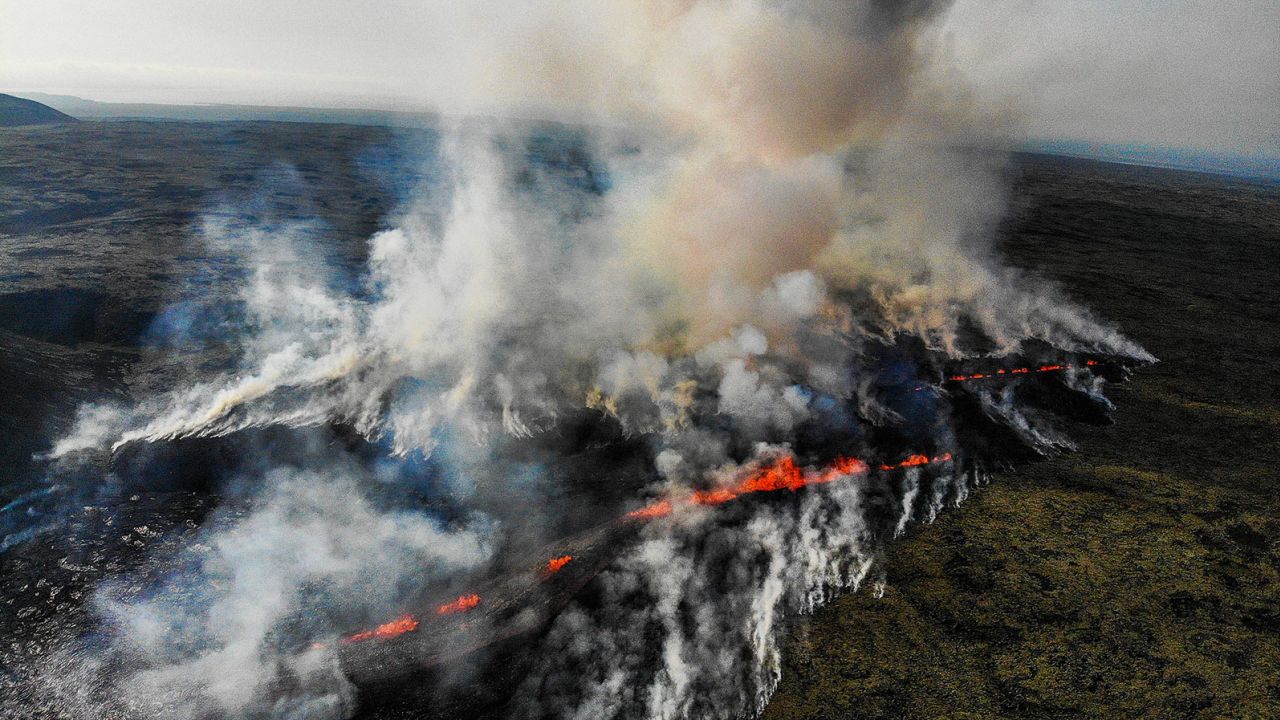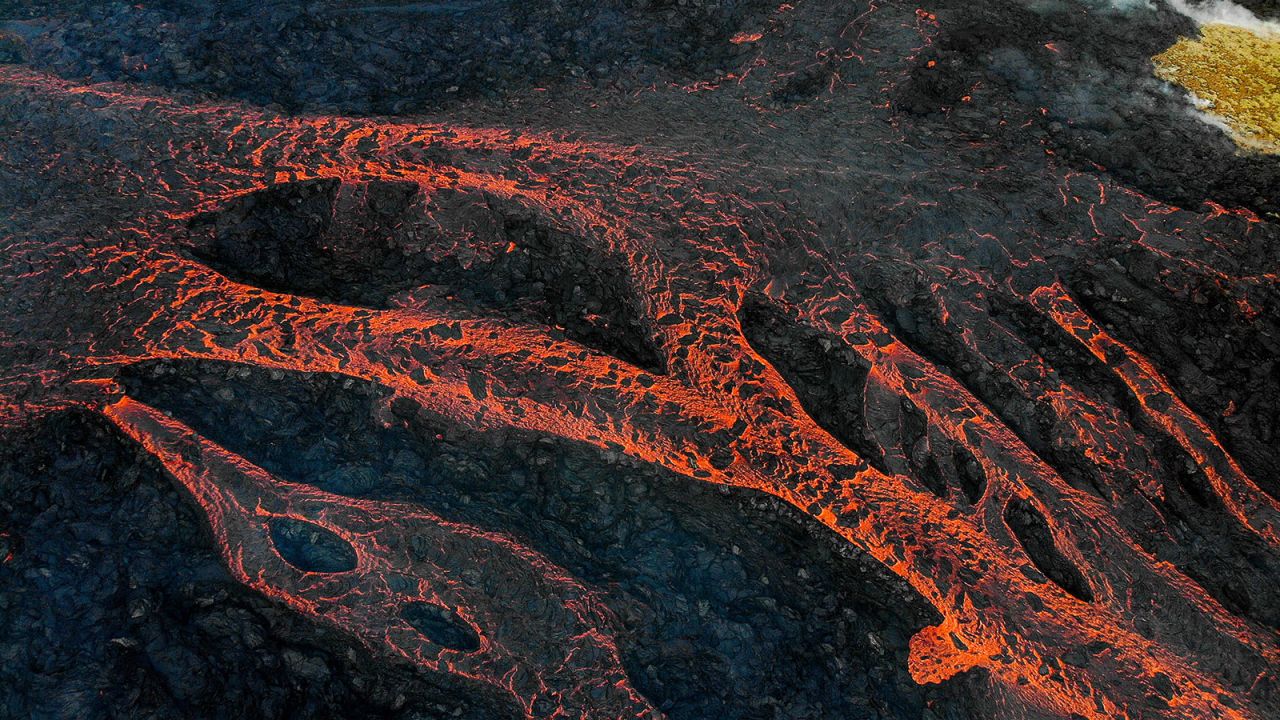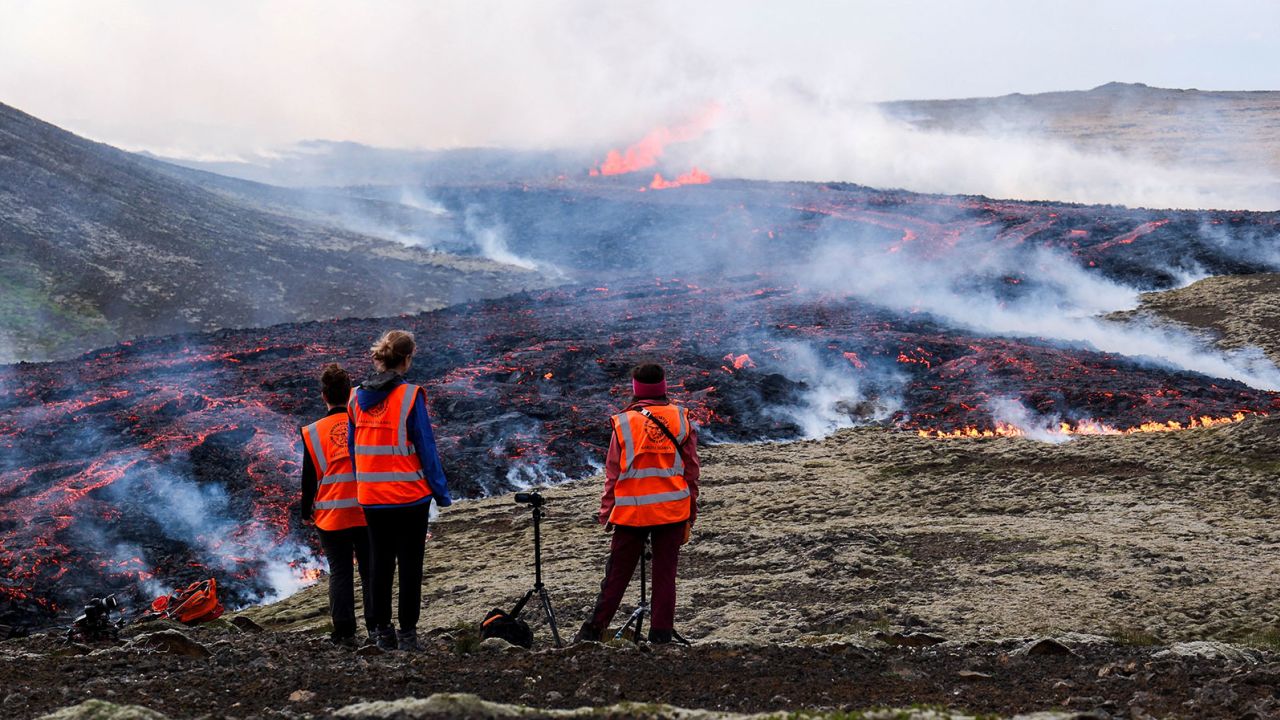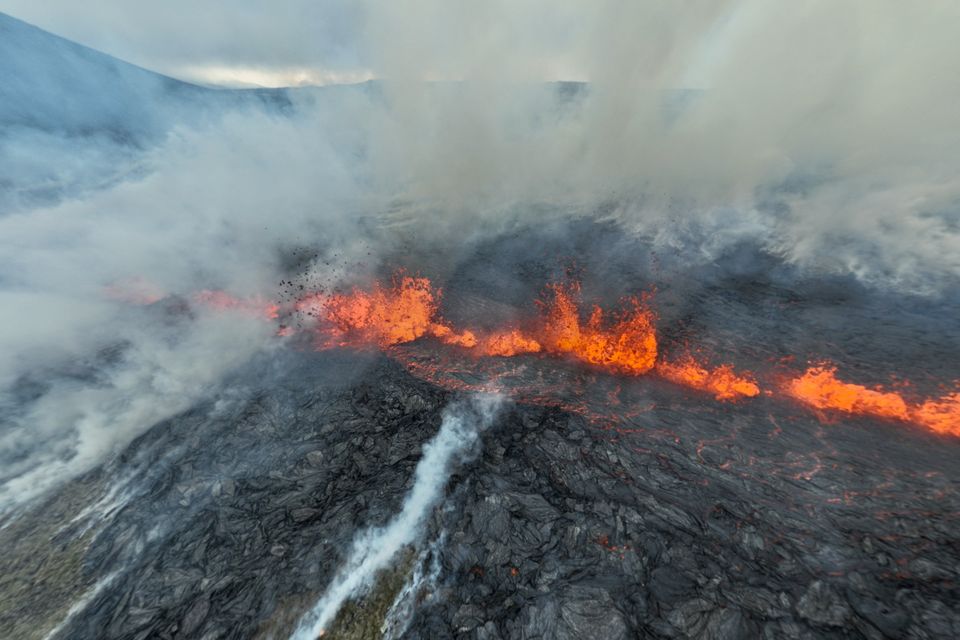Volcano erupts in Iceland after weeks of earthquakes
(160) Reykjanes - Norður - YouTube LIVE STREAMING
By Jessie Yeung, CNN
Published 12:00 AM EDT, Tue July 11, 2023

A volcanic eruption emits smoke and flowing lava south of Reykjavik, Iceland on July 10, 2023.Kristinn Magnusson/AFP/Getty Images
CNN —
A volcanic eruption south of Iceland’s capital Reykjavik is sending plumes of smoke across a region known for its sweeping lava fields, volcanoes and geothermal activity.
The Icelandic Meteorological Office (IMO) said the “minor” eruption began Monday in Iceland’s Reykjanes Peninsula but no ash has been emitted and so far no disruption has been reported at the country’s Keflavik Airport.
The IMO said there was a 200-meter (656 feet) long fissure on the slopes of the Litli Hrútur mountain, “from which lava is emerging as a series of fountains.”
Scientists had warned of possible eruptions after hundreds of minor earthquakes were detected in recent weeks.

Streams of lava near Litli Hrutur, Iceland, on July 10, 2023.Kristinn Magnusson/AFP/Getty Images
Photos show streams of lava flowing along the dark fields, with small fires in the distance and thick smoke billowing in the air.
Since the eruption took place in an uninhabited area, there were no “immediate risks” to communities or infrastructure, the IMO said – but it warned people not to venture near the area, saying there will be an accumulation of “dangerously high levels of volcanic gases.”
The wind will carry some of these gases north, potentially affecting several areas including the Icelandic capital, the IMO said.

Observers from the University of Iceland watch a volcanic eruption near Litli Hrutur, Iceland on July 10, 2023.Kristinn Magnusson/AFP/Getty Images
The Reykjanes Peninsula regional destination management office also issued a warning about gas levels on Monday.
In a statement, the office said the peninsula’s police chief ordered the closure of all trails to the volcano due to “massive gas pollution that is life-threatening,” after speaking with scientists.
Authorities are working to restore access to the volcano once the pollution dies down, it added.
Several days ago, the management office warned hikers in the region to be careful, noting that the recent seismic activity looked similar to the lead-up to another volcanic eruption last year.
CNN —
A volcanic eruption south of Iceland’s capital Reykjavik is sending plumes of smoke across a region known for its sweeping lava fields, volcanoes and geothermal activity.
The Icelandic Meteorological Office (IMO) said the “minor” eruption began Monday in Iceland’s Reykjanes Peninsula but no ash has been emitted and so far no disruption has been reported at the country’s Keflavik Airport.
The IMO said there was a 200-meter (656 feet) long fissure on the slopes of the Litli Hrútur mountain, “from which lava is emerging as a series of fountains.”
Scientists had warned of possible eruptions after hundreds of minor earthquakes were detected in recent weeks.

Streams of lava near Litli Hrutur, Iceland, on July 10, 2023.
Photos show streams of lava flowing along the dark fields, with small fires in the distance and thick smoke billowing in the air.
Since the eruption took place in an uninhabited area, there were no “immediate risks” to communities or infrastructure, the IMO said – but it warned people not to venture near the area, saying there will be an accumulation of “dangerously high levels of volcanic gases.”
The wind will carry some of these gases north, potentially affecting several areas including the Icelandic capital, the IMO said.

Observers from the University of Iceland watch a volcanic eruption near Litli Hrutur, Iceland on July 10, 2023.
The Reykjanes Peninsula regional destination management office also issued a warning about gas levels on Monday.
In a statement, the office said the peninsula’s police chief ordered the closure of all trails to the volcano due to “massive gas pollution that is life-threatening,” after speaking with scientists.
Authorities are working to restore access to the volcano once the pollution dies down, it added.
Several days ago, the management office warned hikers in the region to be careful, noting that the recent seismic activity looked similar to the lead-up to another volcanic eruption last year.
Volcano Begins Erupting In An Uninhabited Valley In Southwest Iceland
The area, known broadly as Fagradalsfjall volcano, has erupted twice in the last two years without causing damage or disruptions to flights despite being near Keflavik Airport, Iceland's international air traffic hub.
 Volcano Begins Erupting In Southwest Iceland Photo: AP/PTILAILA TYABJIAP
Volcano Begins Erupting In Southwest Iceland Photo: AP/PTILAILA TYABJIAP
UPDATED: 11 JUL 2023 10:38 AM
A volcano in southwestern Iceland began erupting Monday, the country's meteorological authorities said, 11 months after its last eruption officially ended. The eruption is in an uninhabited valley near the mountain Litli-Hrútur, some 30 kilometers (19 miles) southwest of the capital, Reykjavik.
The area, known broadly as Fagradalsfjall volcano, has erupted twice in the last two years without causing damage or disruptions to flights despite being near Keflavik Airport, Iceland's international air traffic hub. The airport remained open Monday and no flights were affected.
“The lava fissure appears small at first sight,” television reporter Kristjan Unnarsson, who was aboard a helicopter about an hour after the eruption began Monday afternoon, told viewers. Authorities urged people not to trek to the volcano.
“It is not a little hike,” Kristin Gudmundsdottir, a natural hazard specialist at the Met Office, told The Associated Press. “We need to wait and see how the eruption develops.” A 2021 eruption in the same area produced spectacular lava flows for several months. Hundreds of thousands people flocked to see the spectacular sight. Iceland, which sits above a volcanic hotspot in the North Atlantic, averages an eruption every four to five years.
The most disruptive in recent times was the 2010 eruption of the Eyjafjallajokull volcano, which spewed huge clouds of ash into the atmosphere and led to widespread airspace closures over Europe. More than 100,000 flights were grounded, stranding millions of international travellers and causing air travel for days because of concerns the ash could damage jet engines.
UPDATED: 11 JUL 2023 10:38 AM
A volcano in southwestern Iceland began erupting Monday, the country's meteorological authorities said, 11 months after its last eruption officially ended. The eruption is in an uninhabited valley near the mountain Litli-Hrútur, some 30 kilometers (19 miles) southwest of the capital, Reykjavik.
The area, known broadly as Fagradalsfjall volcano, has erupted twice in the last two years without causing damage or disruptions to flights despite being near Keflavik Airport, Iceland's international air traffic hub. The airport remained open Monday and no flights were affected.
“The lava fissure appears small at first sight,” television reporter Kristjan Unnarsson, who was aboard a helicopter about an hour after the eruption began Monday afternoon, told viewers. Authorities urged people not to trek to the volcano.
“It is not a little hike,” Kristin Gudmundsdottir, a natural hazard specialist at the Met Office, told The Associated Press. “We need to wait and see how the eruption develops.” A 2021 eruption in the same area produced spectacular lava flows for several months. Hundreds of thousands people flocked to see the spectacular sight. Iceland, which sits above a volcanic hotspot in the North Atlantic, averages an eruption every four to five years.
The most disruptive in recent times was the 2010 eruption of the Eyjafjallajokull volcano, which spewed huge clouds of ash into the atmosphere and led to widespread airspace closures over Europe. More than 100,000 flights were grounded, stranding millions of international travellers and causing air travel for days because of concerns the ash could damage jet engines.
Iceland Monitors New Volcanic Eruption
Larger eruptions have disrupted European air travel, but officials said this small one, in an uninhabited area that until recently had been dormant for centuries, posed no immediate risks.
 This image provided by the government of Iceland shows lava flowing as a volcano erupts on the Reykjanes peninsula in southwest Iceland, near the capital Reykjavik on Monday.Credit...Icelandic Meteorological Office via Reuters
This image provided by the government of Iceland shows lava flowing as a volcano erupts on the Reykjanes peninsula in southwest Iceland, near the capital Reykjavik on Monday.Credit...Icelandic Meteorological Office via Reuters
By Orlando Mayorquin
July 10, 2023,
A minor volcanic eruption began on Monday afternoon in an uninhabited area on Iceland’s Reykjanes Peninsula, the country’s weather officials said.
The eruption, which began at 4:40 p.m. U.T.C., was described as small and posing “no immediate risks to communities or infrastructure,” the Icelandic Met Office said.
It is in a zone that rests between the Fagradalsfjall and Keilir volcanic mountains, roughly 20 miles from the country’s coastal capital, Reykjavik, the office said.
Lava was emerging as “a series of fountains” and flowing south from a fissure on the slope of a hill called Litli Hrútur, officials said. Toxic gas and steam emissions from the fissure were drifting to the northwest, according to officials.
“There are no disruptions to flights to and from Iceland and international flight corridors remain open,” Iceland’s foreign affairs ministry said in a statement.
The public was warned to stay away from the eruption as officials continue to assess its development in the coming days.
Situated on the Mid-Atlantic Ridge, the sparsely populated island nation, home to 370,000 people, has a large quantity of volcanic features. Major eruptions have caused havoc far beyond Iceland in the past.
In 2010, ashes from a volcanic eruption there shrouded much of Europe’s skies, causing a major disruption of air travel over much of the continent. And in 1783, an eight-month-long eruption of a volcanic fissure sent haze as far away as Syria and triggered a famine.
Scientists at the Icelandic Met Office had warned of a potential eruption as the area became a hotbed of seismic activity over the past week. Officials reported thousands of earthquakes in the region, with some reaching magnitudes of 4 and 5. Iceland has now seen eruptions on the Reykjanes Peninsula three years in a row.
Earthquake activity also preceded eruptions in 2021 and 2022, officials said. Last year, three tourists were injured when they tried to hike near the site of the eruption to catch a glimpse of the lava.
Volcanic activity in the Reykjanes Peninsula had been “pretty quiet for hundreds of years before these eruptions started,” according to Egill Hauksson, a research professor of geophysics at Caltech who has studied Icelandic seismic activity.
“So this may be a new cycle of activity that may continue for decades,” he added.
Officials said the fissure in this eruption was roughly one kilometer long.
It was unclear Monday if the eruption was expected to grow or how long it would last. They often peak after the first few days, Mr. Hauksson said.
The eruption last year fizzled out after about three weeks. But another eruption that began in March 2021 dragged on for months, according to the United States Geological Survey.
By Orlando Mayorquin
July 10, 2023,
A minor volcanic eruption began on Monday afternoon in an uninhabited area on Iceland’s Reykjanes Peninsula, the country’s weather officials said.
The eruption, which began at 4:40 p.m. U.T.C., was described as small and posing “no immediate risks to communities or infrastructure,” the Icelandic Met Office said.
It is in a zone that rests between the Fagradalsfjall and Keilir volcanic mountains, roughly 20 miles from the country’s coastal capital, Reykjavik, the office said.
Lava was emerging as “a series of fountains” and flowing south from a fissure on the slope of a hill called Litli Hrútur, officials said. Toxic gas and steam emissions from the fissure were drifting to the northwest, according to officials.
“There are no disruptions to flights to and from Iceland and international flight corridors remain open,” Iceland’s foreign affairs ministry said in a statement.
The public was warned to stay away from the eruption as officials continue to assess its development in the coming days.
Situated on the Mid-Atlantic Ridge, the sparsely populated island nation, home to 370,000 people, has a large quantity of volcanic features. Major eruptions have caused havoc far beyond Iceland in the past.
In 2010, ashes from a volcanic eruption there shrouded much of Europe’s skies, causing a major disruption of air travel over much of the continent. And in 1783, an eight-month-long eruption of a volcanic fissure sent haze as far away as Syria and triggered a famine.
Scientists at the Icelandic Met Office had warned of a potential eruption as the area became a hotbed of seismic activity over the past week. Officials reported thousands of earthquakes in the region, with some reaching magnitudes of 4 and 5. Iceland has now seen eruptions on the Reykjanes Peninsula three years in a row.
Earthquake activity also preceded eruptions in 2021 and 2022, officials said. Last year, three tourists were injured when they tried to hike near the site of the eruption to catch a glimpse of the lava.
Volcanic activity in the Reykjanes Peninsula had been “pretty quiet for hundreds of years before these eruptions started,” according to Egill Hauksson, a research professor of geophysics at Caltech who has studied Icelandic seismic activity.
“So this may be a new cycle of activity that may continue for decades,” he added.
Officials said the fissure in this eruption was roughly one kilometer long.
It was unclear Monday if the eruption was expected to grow or how long it would last. They often peak after the first few days, Mr. Hauksson said.
The eruption last year fizzled out after about three weeks. But another eruption that began in March 2021 dragged on for months, according to the United States Geological Survey.
Icelandic volcano erupts near capital Reykjavik
Volcanologists believe the site's new cycle of increased activity could last years
:quality(70)/cloudfront-eu-central-1.images.arcpublishing.com/thenational/XNKWA3JMPCFLC34IVL62AC7EHQ.jpg)
The volcanic eruption near Litli Hrutur, south-west of Reykjavik, Iceland, on July 10. AFP
Soraya EbrahimiJul 10, 2023
A volcano erupted about 30km from the Icelandic capital of Reykjavik on Monday, the country's meteorological office said.
It is the volanco's third eruption in two years, with local media footage showing a massive cloud of smoke rising from the ground and a substantial flow of lava at the site.
The smoke can be seen from the road connecting the capital to the international airport, with cars pulled over and people taking pictures, AFP reported.
UAE sends aid to Philippines after Mayon volcano displaces thousands
"The eruption is taking place in a small depression just north of Litli Hrutur ['Little Ram' in Icelandic] from which smoke is escaping in a north-westerly direction," the meteorological office said.
Thorvaldur Thordarson, professor in volcanology at the University of Iceland, told AFP: "There are three fissures with lava basically running in all directions.
Prof Thordarson said the fissures were in total about 200 to 300 metres long.
"It is a low-intensity, effusive eruption," he said.
This means "it's not causing widespread threats due to explosive activity" but "if the eruption continues for long enough it could be a threat to infrastructure".
Thousands of small earthquakes were recorded in the area in the week leading up to the eruption, indicating that the magma below the ground was moving and an eruption was imminent.
The Icelandic authorities advised against going to the site, which is in difficult terrain without road connections, before they have assessed the situation.
The magma broke through the ground about 4.40pm, just a few kilometres from two previous eruptions in the past two years.
The first was on March 19, 2021, in the Geldingadalur valley and lasted six months, while the second occurred on August 3, 2022, in the Meradalir valley, lasting three weeks.
Before the 2021 eruption, the region had remained dormant for eight centuries, but volcanologists believe the new cycle of increased activity could last several years.
The effusive eruptions that have occurred in this area so far have not been very dangerous, and they have not had any effect on air traffic.
The 2021 and 2022 eruptions attracted hundreds of thousands of visitors hoping to catch a rare glimpse of an active volcano.
Prof Thordarson said the eruption could last from "a few days" to more than half a year like in 2021, or even longer.
Iceland has 33 volcanic systems considered active, the highest number in Europe. It has an eruption every five years on average.
The North Atlantic island straddles the Mid-Atlantic Ridge, a crack in the ocean floor separating the Eurasian and North American tectonic plates.
In April 2010, about 100,000 flights were cancelled, leaving more than 10 million travellers stranded, after the massive eruption of the Eyjafjallajokull volcano.
Other volcanoes, such as Askja in the uninhabited highlands of central Iceland, have recently shown signs of activity.
One of the country's most dangerous volcanoes is Katla, near the south coast. It last erupted in 1918, with an unusually long pause suggesting an imminent reawakening.
The 1783 eruption of the Laki volcanic fissure in the south of the island is considered by some experts to be the most devastating in Iceland's history, causing its biggest environmental and socio-economic disaster.
Between 50 to 80 per cent of Iceland's livestock was killed, leading to a famine that left a quarter of the country's population dead.
The meteorological impact of the eruption also had repercussions for years, with some experts suggesting it may have played a part in starting the French Revolution.
Volcanologists believe the site's new cycle of increased activity could last years
:quality(70)/cloudfront-eu-central-1.images.arcpublishing.com/thenational/XNKWA3JMPCFLC34IVL62AC7EHQ.jpg)
The volcanic eruption near Litli Hrutur, south-west of Reykjavik, Iceland, on July 10. AFP
Soraya Ebrahimi
A volcano erupted about 30km from the Icelandic capital of Reykjavik on Monday, the country's meteorological office said.
It is the volanco's third eruption in two years, with local media footage showing a massive cloud of smoke rising from the ground and a substantial flow of lava at the site.
The smoke can be seen from the road connecting the capital to the international airport, with cars pulled over and people taking pictures, AFP reported.
UAE sends aid to Philippines after Mayon volcano displaces thousands
"The eruption is taking place in a small depression just north of Litli Hrutur ['Little Ram' in Icelandic] from which smoke is escaping in a north-westerly direction," the meteorological office said.
Thorvaldur Thordarson, professor in volcanology at the University of Iceland, told AFP: "There are three fissures with lava basically running in all directions.
Prof Thordarson said the fissures were in total about 200 to 300 metres long.
"It is a low-intensity, effusive eruption," he said.
This means "it's not causing widespread threats due to explosive activity" but "if the eruption continues for long enough it could be a threat to infrastructure".
Thousands of small earthquakes were recorded in the area in the week leading up to the eruption, indicating that the magma below the ground was moving and an eruption was imminent.
The Icelandic authorities advised against going to the site, which is in difficult terrain without road connections, before they have assessed the situation.
The magma broke through the ground about 4.40pm, just a few kilometres from two previous eruptions in the past two years.
The first was on March 19, 2021, in the Geldingadalur valley and lasted six months, while the second occurred on August 3, 2022, in the Meradalir valley, lasting three weeks.
Before the 2021 eruption, the region had remained dormant for eight centuries, but volcanologists believe the new cycle of increased activity could last several years.
The effusive eruptions that have occurred in this area so far have not been very dangerous, and they have not had any effect on air traffic.
The 2021 and 2022 eruptions attracted hundreds of thousands of visitors hoping to catch a rare glimpse of an active volcano.
Prof Thordarson said the eruption could last from "a few days" to more than half a year like in 2021, or even longer.
Iceland has 33 volcanic systems considered active, the highest number in Europe. It has an eruption every five years on average.
The North Atlantic island straddles the Mid-Atlantic Ridge, a crack in the ocean floor separating the Eurasian and North American tectonic plates.
In April 2010, about 100,000 flights were cancelled, leaving more than 10 million travellers stranded, after the massive eruption of the Eyjafjallajokull volcano.
Other volcanoes, such as Askja in the uninhabited highlands of central Iceland, have recently shown signs of activity.
One of the country's most dangerous volcanoes is Katla, near the south coast. It last erupted in 1918, with an unusually long pause suggesting an imminent reawakening.
The 1783 eruption of the Laki volcanic fissure in the south of the island is considered by some experts to be the most devastating in Iceland's history, causing its biggest environmental and socio-economic disaster.
Between 50 to 80 per cent of Iceland's livestock was killed, leading to a famine that left a quarter of the country's population dead.
The meteorological impact of the eruption also had repercussions for years, with some experts suggesting it may have played a part in starting the French Revolution.
Volcano eruption begins in Iceland after earthquakes
A volcanic eruption has begun near Iceland's capital following days of seismic activity, the Met Office says.
Lava is emerging from ruptures that are estimated to be at least 500 metres long, Benedikt Ofeigsson, geophysicist at the Met Office, said by phone. The eruption "does not seem very powerful" but is generating visible steam, he said.
The uninhabited area, on the Reykjanes Peninsula, is near the spot of previous eruptions in 2021 and 2022, around 30 kilometres from the country's capital.
Iceland, which has 30 volcanic systems and more than 600 hot springs, is one of the most geologically active places on earth, due to its position on the mid-Atlantic ridge where the North American and Eurasian tectonic plates meet.
One of the most disruptive volcanic eruptions in Iceland's recent history occurred in 2010, when Eyjafjallajokull in the southern part of the country erupted in an explosion that released a plume of ash so vast that it grounded air traffic across Europe for weeks, resulting in the cancellation of 100,000 flights and affecting over 10 million people.
The eruption that started on Monday is "effusive and will remain that way," said Ofeigsson. "It's not an explosive ash eruption and it's very unlikely it will become explosive."
The main airport, Keflavik, said there are no disruptions to arrivals or departures, according to its website.
It's possible that volcanic activity on the peninsula takes years or decades to conclude, according to Iceland's Met Office.
Smoke billows and lava spurts after the eruption of a volcano, on the Reykjanes peninsula. Photo: Juergen Merz via Reuters


No comments:
Post a Comment